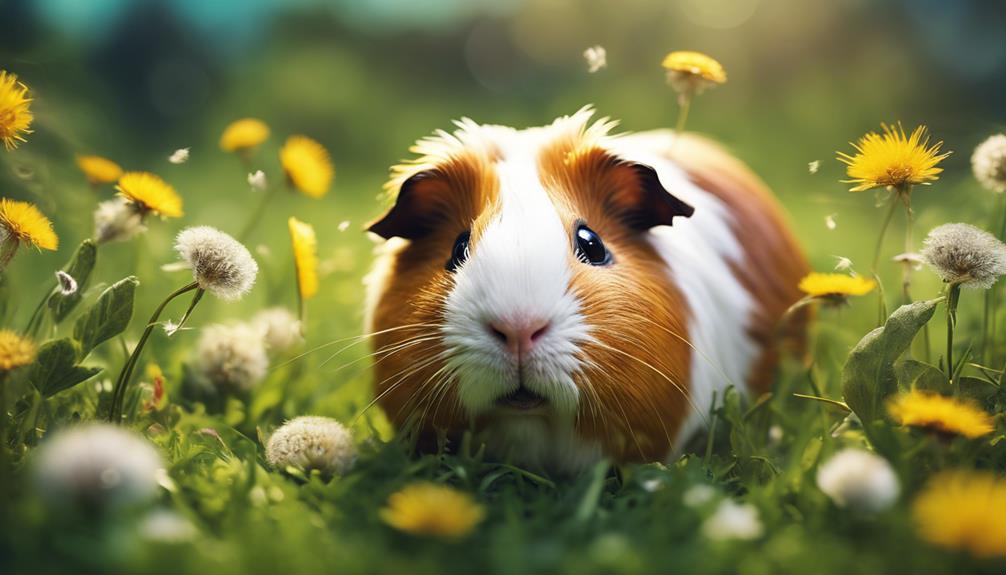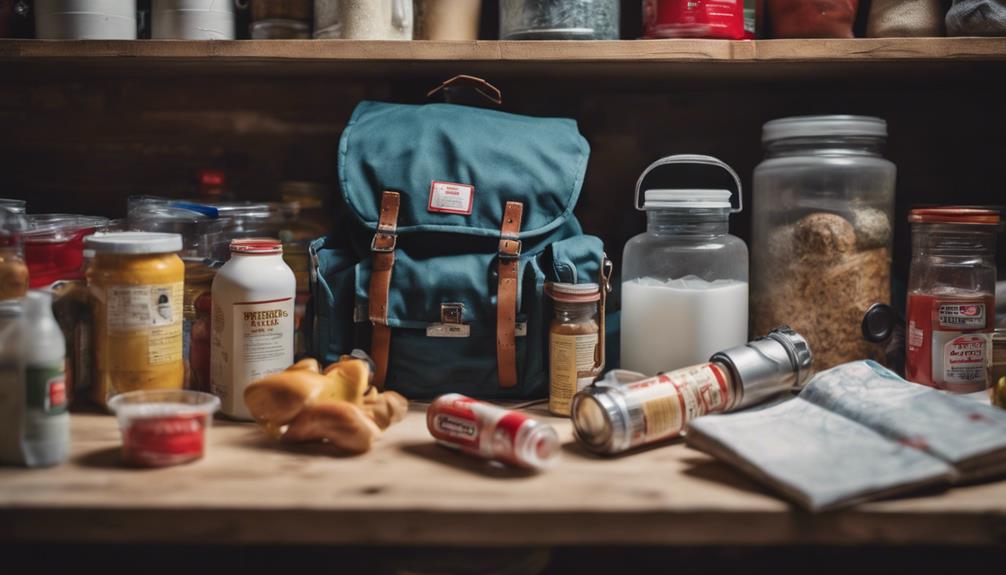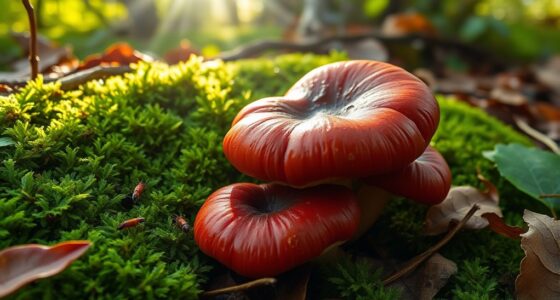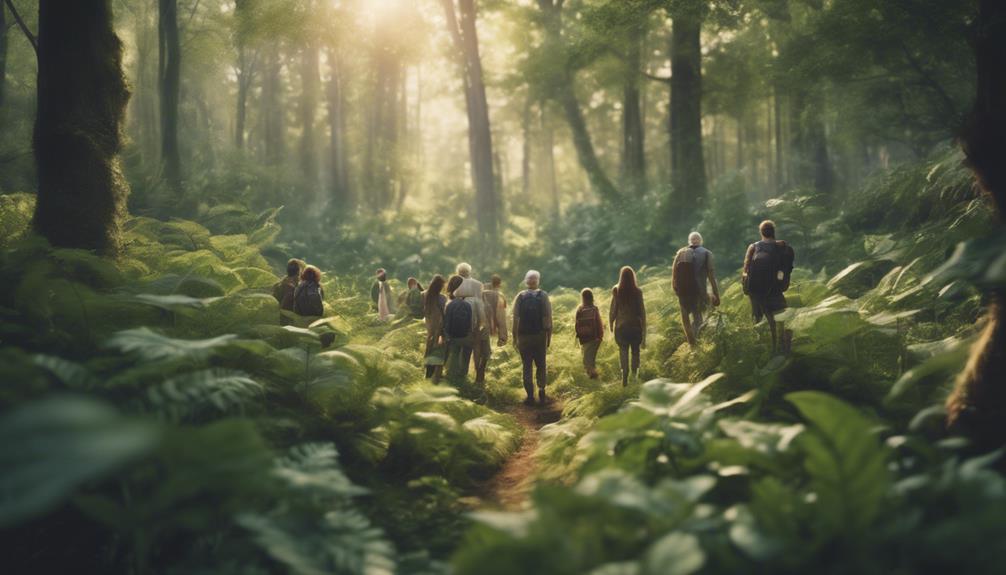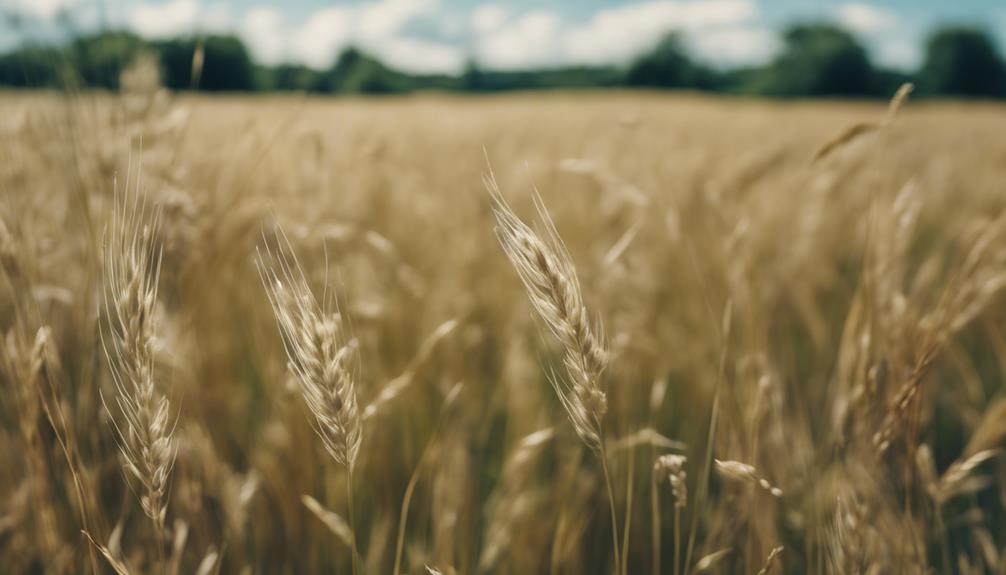You can forage a variety of wild herbs, leaves, flowers, fruits, and weeds that are safe and nutritious for your guinea pigs to enjoy. Look for herbs like Herb Robert, Coltsfoot, and Pineapple Weed, which offer a tasty and healthy snack. For leaves, try Wild Raspberry, Dandelion, and Hazel tree leaves, which are rich in vitamins and fiber. Edible flowers like daisies and pansies make great treats, while fruits like Wild Raspberry and Apple are packed with antioxidants and fiber. By foraging for these wild foods, you can provide your guinea pigs with a nutrient-rich diet; and, by exploring further, you'll discover even more options to keep them happy and healthy.
Key Takeaways
- Forage for nutrient-rich weeds like Dandelion Delights, Common Plantain, and Wild Violets to provide essential vitamins and minerals.
- Offer edible flowers like daisies, violets, and marigolds, ensuring they are pesticide-free.
- Wild greens like Dandelions, Clover, and Purslane are rich in vitamins A and C, making them a great snack.
- Fresh leaves from Hazel, Apple, and Birch trees can be a tasty and healthy treat for your guinea pigs.
- Always identify and avoid toxic plants like Foxglove, Hemlock, and Nightshade to ensure your guinea pigs' safety.
Wild Herbs for Guinea Pig Delight
When foraging for your guinea pig's delight, you'll find a treasure trove of wild herbs in woods, hedge banks, and disturbed areas that'll make their whiskers twitch with joy.
Wild herbs are a great way to add variety to their diet, and they're readily available in nature. One of the easiest to identify is Herb Robert, with its pink flowers and preference for moist areas.
Coltsfoot, with its smooth top and hairy underside, is another favorite that thrives in disturbed areas and woods.
Dead Nettle, a plant similar to stinging nettle but without the sting, grows in woods, waste grounds, and alongside stinging nettles.
You might also stumble upon Wild Raspberry leaves, distinguished by their silvery underside, in woodlands, heathland, and hedgerows.
And don't forget Pineapple Weed, which smells like pineapple when rubbed, thriving in disturbed areas like waste grounds and woodlands.
These wild herbs will provide your guinea pig with a delightful and nutritious snack.
Nutritious Leaves to Forage

As you explore the world of nutritious leaves for your guinea pig, you'll discover a variety of options that can add excitement and nutrition to their diet.
From Dandelion Delights to Wild Lettuce Treats, you'll find that these leaves offer a range of benefits, from boosting vitamin intake to supporting digestive health.
Dandelion Delights
Your guinea pig will love foraging for dandelion leaves, a nutritious treat packed with vitamins, minerals, and fiber. Rich in vitamins A, C, and K, these leaves provide a boost to your pet's overall health. Plus, they're low in calories and high in fiber, promoting digestive health and supporting a healthy weight.
The leaves also contain essential minerals like calcium and iron, crucial for your guinea pig's well-being.
Guinea pigs adore the slightly bitter taste of dandelion leaves, making them a favorite forage choice. Foraging for these leaves also provides mental stimulation, mimicking their natural grazing behavior. By offering dandelion leaves, you're not only providing a tasty snack but also encouraging your guinea pig's natural instincts.
Wild Lettuce Treats
You can also forage for wild lettuce, another nutritious treat that's packed with vitamins and minerals, providing a tasty and healthy snack for your guinea pig. Wild lettuce leaves are a great source of fiber, promoting digestive health in guinea pigs. Plus, they're low in calories, making them a healthy snack option for your pets.
Here's a breakdown of the benefits of wild lettuce leaves for your guinea pigs:
| Benefit | Description |
|---|---|
| Nutrient-rich | Packed with vitamins and minerals |
| Digestive health | High in fiber, promoting healthy digestion |
| Low-calorie snack | A healthy, guilt-free treat option |
Wild lettuce leaves are easy to forage and can be found in various habitats like meadows, woodlands, and roadsides. By offering wild lettuce treats, you can add variety to your guinea pigs' diet and mimic their natural foraging behavior.
Edible Flowers for Treats

Fresh from the garden, edible flowers like daisies, violets, marigolds, and roses can be a delightful surprise for your guinea pigs. These flowers provide a fun and tasty snack, adding variety to their diet. Before feeding them to your pets, make sure they're free of pesticides and chemicals.
You can also try pansies, nasturtiums, and calendula, which are safe and enjoyable options for guinea pigs.
When introducing edible flowers, do it gradually to make certain your guinea pigs tolerate them well. This will help prevent any potential digestive issues. Start with small amounts and monitor their behavior and health. If you notice any adverse reactions, stop feeding them the flowers immediately.
Trees With Tasty Leaves

Beyond the colorful blooms, certain trees offer a bounty of tasty leaves that can be safely foraged for your guinea pigs. You can forage for hazel tree leaves, which are quite a delight for your furry friends.
Apple tree leaves are another option, but make sure to wash them thoroughly before offering them as a treat. Birch tree leaves and twigs are also safe and make for a tasty snack.
If you have a crabapple tree nearby, you're in luck! The leaves are a forage favorite for guinea pigs. And, if you're near a maple tree, you can add its leaves to your guinea pigs' foraged diet for a delightful treat.
When foraging for tree leaves, make sure you correctly identify the tree species to avoid any harm to your pets. Remember to only pick fresh, healthy leaves and avoid any that show signs of damage or disease.
Weeds That Are Safe

As you forage for weeds that are safe for your guinea pigs, you'll want to keep an eye out for some specific varieties.
You'll be excited to learn that Dandelion Delights, Common Plantain, and Wild Violets are all safe options for your furry friends.
These weeds aren't only nutritious but also easily identifiable, making them a great starting point for your foraging adventure.
Dandelion Delights
Pick a handful of dandelions from your yard or a nearby field, and you'll be treating your guinea pig to a nutrient-rich snack that's as tasty as it's healthy. These yellow flowers are abundant in the wild and are a favorite foraged food for guinea pigs.
Here are just a few reasons why dandelions are a great choice for your furry friend:
- Nutrient-rich: Dandelions provide essential vitamins and minerals that are perfect for guinea pigs.
- Aids digestion: Dandelions can help prevent bloating and aid in digestion, keeping your guinea pig happy and healthy.
- Tasty treat: Guinea pigs love the taste of dandelion leaves, flowers, and roots, making it a great snack to add to their diet.
- Abundant and safe: Dandelions are easy to find and, as long as they're pesticide-free, are completely safe for your guinea pig to enjoy.
Remember to always verify the dandelions you forage are free from pesticides before feeding them to your guinea pig.
With their numerous health benefits and delicious taste, dandelions are a great addition to your guinea pig's diet.
Common Plantain
You can easily identify common plantain by its broad, oval-shaped leaves with distinct veins and small, inconspicuous flowers, making it a great addition to your guinea pig's foraged diet. This weed, also known as Plantago Major, is a safe and nutritious treat for your pet. Rich in calcium and possessing antibiotic properties, common plantain can provide several health benefits for your guinea pig. You can let your pet munch on the leaves as part of a varied and healthy foraged diet.
Common plantain is widely available, often found in lawns, meadows, and disturbed areas. It's easy to forage for, making it an excellent option for guinea pig owners. When gathering, make sure you identify the plant correctly and avoid areas that may have been sprayed with pesticides or other harmful chemicals.
Wild Violets
Wild violets, with their delicate purple petals and heart-shaped leaves, offer a nutritious and delicious treat for your guinea pig to forage. These flowers can be found in gardens, meadows, and woodlands, making them a convenient and healthy snack option for your furry friend.
Here are some benefits of feeding wild violets to your guinea pig:
- Nutrient-rich: Wild violets provide essential nutrients like vitamin C, fiber, and antioxidants.
- Mild flavor: Guinea pigs love the mild, sweet flavor of wild violets.
- Low calorie: The leaves and flowers of wild violets are low in calories, making them a healthy snack option.
- Stimulates foraging instincts: Foraging wild violets can add variety to your guinea pig's diet and stimulate their natural foraging instincts.
Remember to always identify wild violets correctly before offering them to your guinea pig, and introduce them in moderation to promote a balanced diet.
Fruits and Berries Galore

Fresh from the great outdoors, fruits and berries offer a tantalizing array of snacks for your guinea pig to savor. You can forage for a variety of fruits and berries that are both nutritious and delicious for your pet.
| Fruit/Berry | Nutritional Benefits | Fun Fact |
|---|---|---|
| Wild Raspberry | Rich in vitamins and antioxidants | The leaves are a favorite among guinea pigs! |
| Crabapple | High in Vitamin C and fiber | Tart and crunchy, a perfect snack! |
| Wild Strawberry | Packed with antioxidants and sweet flavor | A delightful and healthy treat! |
| Apple | Fiber-rich and juicy | From wild apple trees, a tasty find! |
Some of these fruits and berries are rich in vitamins, antioxidants, and fiber, making them a great addition to your guinea pig's diet. For example, wild raspberries are a favorite among guinea pigs, and their leaves are a nutritious snack too! Crabapples provide a crunchy and tart treat, while wild strawberries offer a sweet and healthy option. Apples from wild apple trees are another juicy and fiber-rich snack for your pet.
Common Yard Finds

What common yard finds can you discover to delight your guinea pig's palate? As you explore your outdoor space, you'll be surprised by the variety of treats waiting to be discovered. Here are some common yard finds that your guinea pigs will love:
- Dandelions: A classic favorite, dandelions are rich in vitamins and minerals.
- Clover: White or red, clover is a tasty and nutritious snack.
- Plantago: Also known as plantain, this weed is packed with fiber and vitamins.
- Coltsfoot: The leaves and stems of this plant make a delicious and healthy treat.
In addition to these finds, you can also forage for herbs like herb robert, yarrow, and pineapple weed. Trees such as hazel, apple, and birch provide safe and nutritious leaves and twigs for your guinea pigs.
Remember to always verify plants correctly and make sure they're free of pesticides and other harmful substances before offering them to your pets. Happy foraging!
Wild Greens for Vitamins

Rich in essential vitamins, foraged greens like dandelions, clover, and purslane can become a vital powerhouse in your guinea pig's diet. These wild greens are packed with vitamins A and C, which are essential for maintaining your pet's overall health. By incorporating these greens into their diet, you can help boost their immune function, support digestion, and promote overall well-being.
In addition to dandelions, clover, and purslane, you can also forage for other nutrient-dense greens like plantago, daisies, and wild raspberry leaves. These plants provide a diverse range of vitamins and minerals that cater to your guinea pig's daily nutritional needs.
Additionally, wild foods like hazel leaves, apple twigs, and meadow sweets offer natural sources of antioxidants, which are vital for maintaining your pet's health. By providing a mix of wild greens, you can make sure your guinea pig receives a broad spectrum of nutrients to thrive.
Avoid These Toxic Plants

As you forage for wild greens, it's equally important to know which plants to avoid, as some can be toxic to your guinea pigs. Toxic plants can cause serious health issues or even be fatal to your pets if ingested. It's essential to be able to identify and steer clear of these plants to guarantee the safety and well-being of your guinea pigs.
Here are some toxic plants to watch out for:
- Foxglove: Its leaves and flowers contain a toxic compound that can be fatal to guinea pigs.
- Hemlock: This plant can cause respiratory failure, seizures, and even death in guinea pigs.
- Nightshade: Both the leaves and berries of nightshade are toxic to guinea pigs and can cause vomiting, diarrhea, and abdominal pain.
- Buttercup: The sap of the buttercup plant contains a toxic compound that can cause oral and gastrointestinal irritation in guinea pigs.
Frequently Asked Questions
What Is the Best Forage for Guinea Pigs?
You're wondering what's the best forage for your guinea pigs? Dandelions, clover, and wild raspberry leaves are top picks, providing fresh nutrients and mimicking their natural feeding behavior, but don't forget to mix it up for a balanced diet. In addition to guinea pigs, these plants are also great safe forage options for rabbits, promoting healthy digestion and offering variety in their diet. Make sure to avoid plants that are toxic, such as buttercups or daffodils, and always collect forage from areas free of pesticides. Both guinea pigs and rabbits will benefit from regular access to fresh forages alongside hay and pellets for a well-rounded diet.
What Food Do Guinea Pigs Love the Most?
As you imagine your guinea pigs' joyful chirps and twitching whiskers, you wonder what they crave most – and the answer is dandelion greens, a sweet and tangy treat that'll make their eyes shine with delight!
What Can Guinea Pigs Eat in the Wild?
You're wondering what wild treats your guinea pigs can munch on? They'll love snacking on dandelions, clover, and wild raspberry leaves, which are all safe and nutritious options that'll add variety to their diet.
How to Make Forage for Guinea Pigs?
As you step into the wild, the sun-kissed meadow unfurls like a green carpet, inviting you to start on a foraging adventure. You'll gather dandelions, clover, and plantago, washing them thoroughly before serving them to your guinea pigs in small, rotated portions.
Conclusion
As you venture out to forage for your guinea pigs, remember that their taste buds are like a treasure chest, waiting to be filled with nature's goodies.
By incorporating these wild edibles into their diet, you'll be giving them a treasure trove of nutrients and flavors.
Just as a chef carefully selects ingredients for a recipe, you're curating a menu that will delight your furry friends and keep them healthy and happy.

